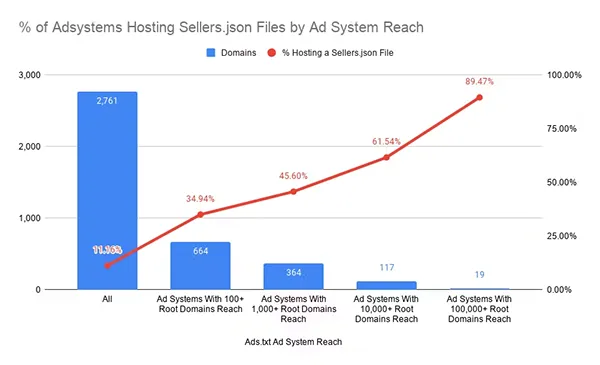Explore Quick SmartHub Guide to Sellers.json: Resolve Any Questions You Have

Just like a moth to a flame, wherever there is money, there will always be someone trying to steal that money.
And, trust me, the digital advertising space is no different, Ad fraud is one of the biggest challenges they face.
In fact, in the United States alone, nearly 18% of ad impressions served are fraudulent. It is estimated that in 2023, ad fraud will have caused advertisers to lose up to $88 billion.
To counter this, the Interactive Advertising Bureau (IAB) introduced sellers.json to increase supply-side confidence in real-time programmatic bidding and buying.
This allows advertisers to verify the authenticity of direct sellers and intermediary sellers of ad inventory.
It prevents unauthorized reselling of inventory and mitigates the risk of ad fraud.

How does sellers.json work?
In the file, SSPs and exchanges will have to list all their authorized reseller partners with their seller ID number and any details of the legal entity that owns that company.
For example, just imagine that you’re a buyer purchasing through an ad exchange.
Let’s say you bid one dollar through one famous magazine.
What sellers.json allows you to do is see the channel through which you’re buying, so to speak.
The node system with sellers.json specification will show you (the advertiser) which channels take the fewest “breaks” in the buying process.
Without this kind of transparency, there will be just so many middlemen who will devalue the impression value until only a fraction is left for the final reseller.
As a result, the greater the discount from the initial offer, the lower the publisher’s payment.
Note: It is customary for exchanges to take a portion of the monetary value of programmatic transactions. That’s why publishers (and advertisers) should try to find the cleanest and most direct path through the supply chain to buy/sell.
The main reason why the IAB created sellers.json was that they wanted a protocol that everyone could use and that wouldn’t be too technically difficult to implement.
So putting a simple .json file on a website was an easy way to achieve this goal.
In the same way, ads.txt is the easiest way to stamp your stock of ads for sale with a list of approved sellers.
So that’s the supply side, and then the demand side, that’s the Sellers.json.
DID YOU KNOW?
Every advertising system listed in an ads.txt file and any advertising system that is referenced from a SupplyChain object node should publish a Sellers.json file at the following location: http://{advertising_system_domain}/sellers.json
Why is sellers.json important?
Sellers.json is significant because it creates more trust on the seller’s side. There are fewer intermediaries in the process, which often leads to better results for the advertiser and publisher.
That said, sometimes these intermediaries can add value, can’t they?
It all depends.
If a special targeting cookie is the reason you go to the SmartHub for assistance, you might not be able to go through an ad exchange.
But in general, and in the vast majority of possibilities, if the entity is simply reselling an ad exchange, it feels like it’s not adding value.
Let’s look at two different scenarios in the buying and selling process to illustrate why sellers.json is important:
Note: Keep in mind that the processes that are described in both scenarios actually happen instantaneously in programmatic buying (about 100ms)
Scenario 1:
When a visitor visits a publisher’s website, this action triggers an RFQ.
The bid request contains data about the user, which may include elements such as demographics, retargeting for browsing history, and more, which is transmitted to the Ad Exchange (Google’s Ad Exchange for this example).
This data is transmitted to all advertisers, and they all make real-time offers. The advertiser with the highest bid wins.
A sellers.json file shows the advertiser the direct path to the sale.
This might look something like this:
- The visitor visits the website
- A bid request is transmitted to the ad exchange
- The advertiser wins the bid
- The ad is displayed on the publisher’s website.
Scenario 2:
The advertiser works with some ad networks. An impression becomes available on Google’s AdX (Ad Exchange).
So they make a bid and buy the impression.
Then it turns out that the impression was listed on AdX by a reseller called XYZMedia, who bought it from the publisher via header bidding.
It looks like this:
- The visitor visits the website
- The reseller has purchased the impression via header bidding
- The impression is listed on AdX
- The advertiser wins the auction
- The ad is shown on the publisher’s website.
Rubicon Ad Network could have purchased it for its advertiser directly via AdX, which would then have gone directly to the publisher.
In scenario 2, there’s a middleman between the advertiser and the ad exchange. sellers.json would give you an idea of how many routes you’re taking to buy this ad inventory.
So, as an advertiser, if you bid a dollar, what are the chances it will be reduced to 60 cents before it reaches the publisher?
If the middlemen siphon off the value of the mix, you risk not being competitive at that price as an advertiser.
That’s why sellers.json is so important. In general, the digital advertising space is filled with hundreds (if not thousands) of players who siphon off value. Still, the value they give back to publishers is vague and often difficult to quantify.
Choose the Best: sellers.json vs. ads.txt
The best way to describe the difference between sellers.json and Ads.txt is that sellers.json is a means of enabling buyers to discover and verify the sellers or intermediaries of the digital advertising opportunity for purchase.
Whereas, ads.txt is on the publisher’s side and is a list of its authorized digital sellers.
In simple terms, sellers.json is a .JSON file that tracks where advertising dollars have gone.
On the other hand, ads.txt is a text file that the publisher must put on his page and that indicates who is selling his advertising stock.
Both sellers.json and ads.txt were created to add trust and transparency to programmatic advertising.

More than 90% of Ad Systems with over 100k domains reach use a sellers.json file.
To Sum Up
In conclusion, the reason SmartHub’s scope of tools like sellers.json (and ads.txt) was introduced is to provide advertisers with a cleaner environment where they can buy inventory without impersonation and rogue middlemen siphoning value away from advertisers and publishers.
Having transparency labels such as sellers.json and ads.txt allows the industry to use them as indicators of quality on both the supply and demand sides of programmatic advertising.















